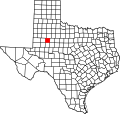History
Native Americans
Shoshone and the Penateka band of Comanches were early tribes in the area. [5]
County established
Borden County was created in 1876 from Bosque County and named for Gail Borden Jr., the inventor of condensed milk. Borden was publisher and editor of the Telegraph and Texas Register , as well as a political leader in the Republic of Texas. The county was organized in 1891, and Gail was made the county seat. [6]
Farmers and ranchers settled the county, but the population remained relatively small. In 1902, Texas placed lands in the public domain and spurred a land rush in Borden County. Many of the newcomers grew cotton. [5]
Borden County has had two courthouses, one built in 1890. The current courthouse is of brick and concrete construction and was erected in 1939. The architect was David S. Castle Co. [7]
Oil was discovered in the county in 1949. By 1991, more than 340,000,000 barrels (54,000,000 m3) of petroleum had been taken out of Borden County since its discovery. [8]
Demographics
Borden County, Texas – Racial and ethnic composition
Note: the US Census treats Hispanic/Latino as an ethnic category. This table excludes Latinos from the racial categories and assigns them to a separate category. Hispanics/Latinos may be of any race.| Race / Ethnicity (NH = Non-Hispanic) | Pop 2000 [13] | Pop 2010 [14] | Pop 2020 [15] | % 2000 | % 2010 | % 2020 |
|---|
| White alone (NH) | 624 | 539 | 528 | 85.60% | 84.09% | 83.68% |
| Black or African American alone (NH) | 1 | 0 | 1 | 0.14% | 0.00% | 0.16% |
| Native American or Alaska Native alone (NH) | 2 | 2 | 0 | 0.27% | 0.31% | 0.00% |
| Asian alone (NH) | 0 | 1 | 0 | 0.00% | 0.16% | 0.00% |
| Pacific Islander alone (NH) | 0 | 0 | 0 | 0.00% | 0.00% | 0.00% |
| Other race alone (NH) | 0 | 0 | 1 | 0.00% | 0.00% | 0.16% |
| Mixed race or Multiracial (NH) | 15 | 4 | 15 | 2.06% | 0.62% | 2.38% |
| Hispanic or Latino (any race) | 87 | 95 | 86 | 11.93% | 14.82% | 13.63% |
| Total | 729 | 641 | 631 | 100.00% | 100.00% | 100.00% |
As of the census [16] of 2000, 729 people, 292 households, and 216 families resided in the county. The population density was 0.80 people per square mile (0.31 people/km2). The 435 housing units averaged 0.48 units per square mile (0.19/km2). The racial makeup of the county was 90.53% White, 0.14% African American, 0.27% Native American, 6.31% from other races, and 2.74% from two or more races. About 11.93% of the population was Hispanic or Latino of any race.
Of the 292 households, 30.10% had children under the age of 18 living with them, 65.10% were married couples living together, 6.20% had a female householder with no husband present, and 25.70% were not families. Around 22.60% of all households consisted of individuals, and 9.20% had someone living alone who was 65 years of age or older. The average household size was 2.50 and the average family size was 2.93.
In the county, the population was distributed as 24.60% under the age of 18, 6.70% from 18 to 24, 27.40% from 25 to 44, 25.00% from 45 to 64, and 16.30% who were 65 years of age or older. The median age was 40 years. For every 100 females, there were 103.10 males. For every 100 females age 18 and over, there were 108.30 males.
The median income for a household in the county was $29,205, and for a family was $36,458. Males had a median income of $25,556 versus $21,607 for females. The per capita income for the county was $18,364. About 14.00% of the population and 11.80% of families were below the poverty line. Of the total people living in poverty, 14.30% were under the age of 18 and 11.60% were 65 or older.
The county is served by nearby radio stations KBXJ (FM) and KPET (AM), and the various Midland and Odessa radio and TV stations.
The largest self-reported ancestry groups in Borden County are: [17] · English – 17% · Irish – 15% · German – 12% · Mexican – 9% · French (except Basque) – 3% · Scotch-Irish – 3% · Other Hispanic or Latino – 3% · Scottish – 2% · Spanish – 1% · American Indian tribes, specified – 1%
This page is based on this
Wikipedia article Text is available under the
CC BY-SA 4.0 license; additional terms may apply.
Images, videos and audio are available under their respective licenses.









